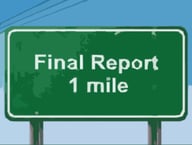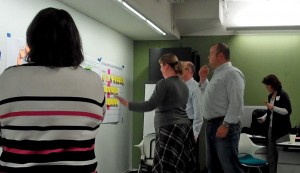 Preparing the final report for a long-term client engagement, I revisited our project management techniques relative to what goes into the document. Certainly The Brainzooming Group has nuances regarding how we conduct and create the final report for a strategy session we facilitate. Our new and reconfirmed project management techniques for closing out big projects, however, will be valuable to you when you are on the hook to prepare a final report of your own.
Preparing the final report for a long-term client engagement, I revisited our project management techniques relative to what goes into the document. Certainly The Brainzooming Group has nuances regarding how we conduct and create the final report for a strategy session we facilitate. Our new and reconfirmed project management techniques for closing out big projects, however, will be valuable to you when you are on the hook to prepare a final report of your own.
5 Final Report Success Tips
1. A final report is about the valuable output, not all the inputs
The important part of a final report is the set of recommendations from the project effort. While individual ideas generated along the way may have been interesting, their value as standalone ideas is secondary if they were not incorporated into the recommendations. While this is not surprising, there is still a part of me that struggles with not including all the ideas we had along the way into the final report for whatever value they may have in the future. Slowly, however, I am getting over this.
2. Do not waste too much time working out of sequence on the final report
Preparing the final report of a project that is complex will not necessarily happen in sequential order. If you are stuck trying to work on the beginning of the report, your inclination may be to start skipping around between sections to make at least some forward progress. As a project management technique, that is worth a try, but resist the inclination to skip around too much. Instead, settle on the section you think you have the best chance of advancing and focus on pushing that section of the final report forward for an extended time. Doing this lets you build momentum in a way that skipping around will not.
3. Print the final report draft and spread it out
When you have a big final report document underway, it is possible you will only be able to go so far organizing it onscreen. This is especially true if you need to make significant changes to move the final report of the project toward completion. If you find yourself staring at the screen for more than ten minutes unable to make a move to rearrange it, print the document (or at least a section of it) and use a paper copy you can spread out, reorder, and discover a better way to organize it.
4. Some final report sections may not fit and aren’t worth any more time
If a project is strategic, creative, and/or developmental in nature, by the time you get close to completion, you may have sections of the final report in both varying stages of completion and applicability. Some sections may seem less applicable the further along you get in preparing the report. Do not be reluctant to yank those sections from the final report if you cannot reasonably fix or complete them efficiently or on a timely basis.
5. Finishing can involve taking things away, not doing more
Looking at this project at one point, my comment was, “It’s too much and too little at the same time.” Sounds like Goldilocks when you read it here. The point is for as much as completing the final report of a project “seems” to be about adding more things, if you’re getting lost in how to complete it, smartly removing things may be the fastest way to get a project done.
What project management techniques help you finish the final report of a project?
We have many readers who have project management responsibilities, so what works for you in completing a significant final report document? Or what have you tried and found to not work – even though you would think it would? Getting projects closed out is a valuable skill, so we’d appreciate hearing your successes. – Mike Brown
If you enjoyed this article, subscribe to the free Brainzooming blog email updates.
Does your organization have good ideas, but lacks the wherewithal to bring them to reality? The Brainzooming Group and our collaborative, implementation-oriented project management techniques will quickly move you toward success. Email us at info@brainzooming.com or call 816-509-5320 for a free consultation on how to get started.



